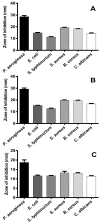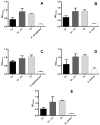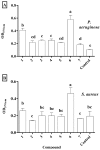Antibacterial Properties of Flavonoids from Kino of the Eucalypt Tree, Corymbia torelliana
- PMID: 28906457
- PMCID: PMC5620595
- DOI: 10.3390/plants6030039
Antibacterial Properties of Flavonoids from Kino of the Eucalypt Tree, Corymbia torelliana
Abstract
Traditional medicine and ecological cues can both help to reveal bioactive natural compounds. Indigenous Australians have long used kino from trunks of the eucalypt tree, Corymbia citriodora, in traditional medicine. A closely related eucalypt, C. torelliana, produces a fruit resin with antimicrobial properties that is highly attractive to stingless bees. We tested the antimicrobial activity of extracts from kino of C. citriodora, C. torelliana × C. citriodora, and C. torelliana against three Gram-negative and two Gram-positive bacteria and the unicellular fungus, Candida albicans. All extracts were active against all microbes, with the highest activity observed against P. aeruginosa. We tested the activity of seven flavonoids from the kino of C. torelliana against P. aeruginosa and S. aureus. All flavonoids were active against P. aeruginosa, and one compound, (+)-(2S)-4',5,7-trihydroxy-6-methylflavanone, was active against S. aureus. Another compound, 4',5,7-trihydroxy-6,8-dimethylflavanone, greatly increased biofilm formation by both P. aeruginosa and S. aureus. The presence or absence of methyl groups at positions 6 and 8 in the flavonoid A ring determined their anti-Staphylococcus and biofilm-stimulating activity. One of the most abundant and active compounds, 3,4',5,7-tetrahydroxyflavanone, was tested further against P. aeruginosa and was found to be bacteriostatic at its minimum inhibitory concentration of 200 µg/mL. This flavanonol reduced adhesion of P. aeruginosa cells while inducing no cytotoxic effects in Vero cells. This study demonstrated the antimicrobial properties of flavonoids in eucalypt kino and highlighted that traditional medicinal knowledge and ecological cues can reveal valuable natural compounds.
Keywords: Eucalyptus; Pseudomonas aeruginosa; Tetragonula; antibiotic resistance; antimicrobial activity; cytotoxicity; ethnobotany; natural products; stingless bees; traditional medicine.
Conflict of interest statement
The authors declare no conflict of interest.
Figures





Similar articles
-
Chemical constituents of kino extract from Corymbia torelliana.Molecules. 2014 Nov 4;19(11):17862-71. doi: 10.3390/molecules191117862. Molecules. 2014. PMID: 25375331 Free PMC article.
-
Anti-staphylococcal activity of C-methyl flavanones from propolis of Australian stingless bees (Tetragonula carbonaria) and fruit resins of Corymbia torelliana (Myrtaceae).Fitoterapia. 2014 Jun;95:247-57. doi: 10.1016/j.fitote.2014.03.024. Epub 2014 Apr 4. Fitoterapia. 2014. PMID: 24704551
-
Do Hybrid Trees Inherit Invasive Characteristics? Fruits of Corymbia torelliana X C. citriodora Hybrids and Potential for Seed Dispersal by Bees.PLoS One. 2015 Sep 29;10(9):e0138868. doi: 10.1371/journal.pone.0138868. eCollection 2015. PLoS One. 2015. PMID: 26418155 Free PMC article.
-
Screening for bioactive secondary metabolites in Sri Lankan medicinal plants by microfractionation and targeted isolation of antimicrobial flavonoids from Derris scandens.J Ethnopharmacol. 2020 Jan 10;246:112158. doi: 10.1016/j.jep.2019.112158. Epub 2019 Aug 14. J Ethnopharmacol. 2020. PMID: 31421182
-
The influence of pre- and post-zygotic barriers on interspecific Corymbia hybridization.Ann Bot. 2012 Jun;109(7):1215-26. doi: 10.1093/aob/mcs050. Epub 2012 Mar 14. Ann Bot. 2012. PMID: 22419764 Free PMC article.
Cited by
-
Formulation of a Novel Hesperetin-Loaded Nanoemulsion and Its Promising Effect on Osteogenesis.Pharmaceutics. 2024 May 23;16(6):698. doi: 10.3390/pharmaceutics16060698. Pharmaceutics. 2024. PMID: 38931821 Free PMC article.
-
The impact of flavonoids-rich Ziziphus jujuba Mill. Extract on Staphylococcus aureus biofilm formation.BMC Complement Med Ther. 2020 Jun 17;20(1):187. doi: 10.1186/s12906-020-2833-9. BMC Complement Med Ther. 2020. PMID: 32552790 Free PMC article.
-
Fungal Biotransformation of 2'-Methylflavanone and 2'-Methylflavone as a Method to Obtain Glycosylated Derivatives.Int J Mol Sci. 2021 Sep 5;22(17):9617. doi: 10.3390/ijms22179617. Int J Mol Sci. 2021. PMID: 34502526 Free PMC article.
-
Flavonoids, gut microbiota, and host lipid metabolism.Eng Life Sci. 2023 Nov 13;24(5):2300065. doi: 10.1002/elsc.202300065. eCollection 2024 May. Eng Life Sci. 2023. PMID: 38708419 Free PMC article. Review.
References
LinkOut - more resources
Full Text Sources
Other Literature Sources

